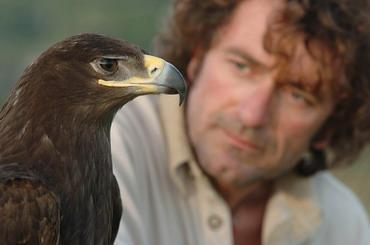An investigation has been opened here into the causes of a plane crash which killed Angelo D'Arrigo, the world champion hang-glider known as the 'Human Condor' for his record-breaking feats.
D'Arrigo, 45, was killed when a Sky Arrow 650 TNT he was a passenger in unexpectedly took a nosedive during an air show at a former military base in Comiso. The two-seater light aircraft crashed in an olive grove killing D'Arrigo and the plane's pilot, 63-year-old retired Air Force General Giulio De Marchis.
A Sky Arrows official, Arabella Bortolotti, said she had been with General De Marchis when he flew the plane to Comiso on Friday and that it was one of the company's newest aircraft.
According to Bortolotti, "the plane was making a turn to prepare for landing when it apparently stalled. It's mind boggling to think that two of Italy's best pilots were aboard".
Catania Mayor Umberto Scapagnini said after the crash said "the tragic death of our brave and famous co-citizen leaves us shocked and speechless. To die in such a way after having shown such incredible flying ability is truly absurd".
Last January D'Arrigo broke the world hang-gliding record for altitude, which he himself set two years earlier in the Himalayas.
The Catania native chose the Andes Mountains to stage his feat and in preparation for it he became the first human to hang-glide over the chain's highest mountain, Aconcagua.
D'Arrigo set the previous hang-gliding altitude record several days after he became the first person to free-fly over over Mt. Everest.
The Argentinian press dubbed D'Arrigo "The Human Condor", after the giant South American vulture on which D'Arrigo has in part designed his "Delta Condor" hang-glider.
Looking back at his flight over Mt. Aconcagua, D'Arrigo told ANSA that "at a certain point when I was flying my glider, which has wings that resemble the bird's flight feathers, I almost felt as if I were a condor". Aside from the altitude record, D'Arrigo also held the hang-gliding record for non-stop distance, 1,830km; the altitude record with a hydroplane, 6,500m; and the world record for speed of climb.
He was also the first person to hang-glide over the Mediterranean, from Catania to Cairo; over the Sahara, from Cairo to Casablanca; and to hang-glide over Mt. Etna, Europe's biggest volcano, 6,480m. At the time of his death, D'Arrigo was already planning his next mission which in 2007 would have seen him attempting to fly over the 5,500m Mt. Wilson in Antarctica.
D'Arrigo took part in a number of scientific expeditions including accompanying Siberian cranes with his hang-glider on their migration from Siberia, across Kazakhstan and all the way to Iran, for a total distance of 5,500 km.
He also accompanied the migration of hawks from central Africa, across the Sahara and Mediterranean into Europe.
These missions had all been part of his Project Metamorphosis, which he began in 2000. The aim of the project was to mix sports, ecology and naturalism to discover the secrets of flight and the migratory routes of great glider birds across five continents.
D'Arrigo had also continued research on the laws of imprinting following in the footsteps of Nobel Prize winner Konrad Lorenz.
This included "becoming a parent" to a newborn bird and following it on the ground from the moment it emerged from its egg.
He developed a special strategy to teach the bird to fly, following it in his hang-glider like a parent, to hunt and to learn the currents used in migration.
When asked why he attempted such feats and adventures, D'Arrigo replied: "By pushing our limits a little further back each day, step by step, we conquer the fears which stop or limit us from taking possession of our own existence".
Italy's National Geographic and Adventure One television channels on Monday rebroadcast a number of documentaries on D'Arrigo as well as nature and adventure shows he hosted and helped to produce.








